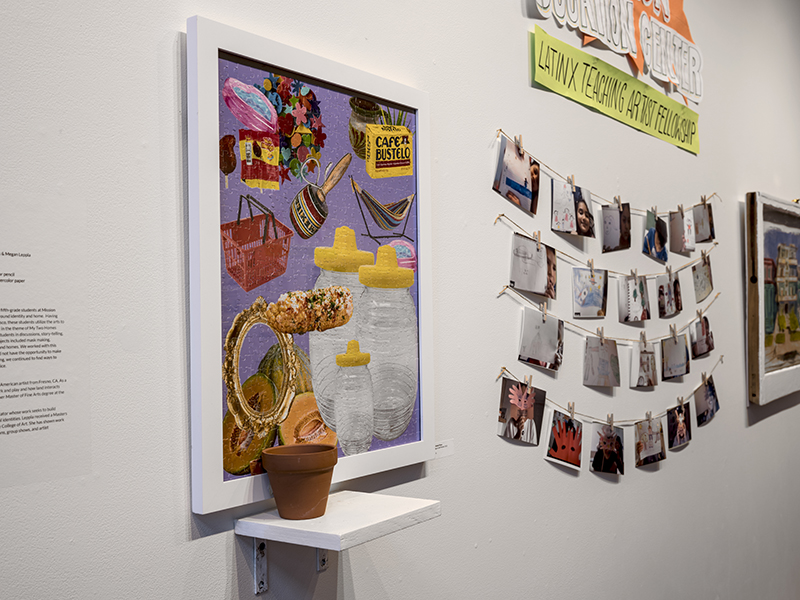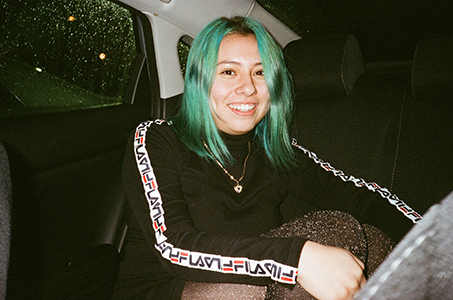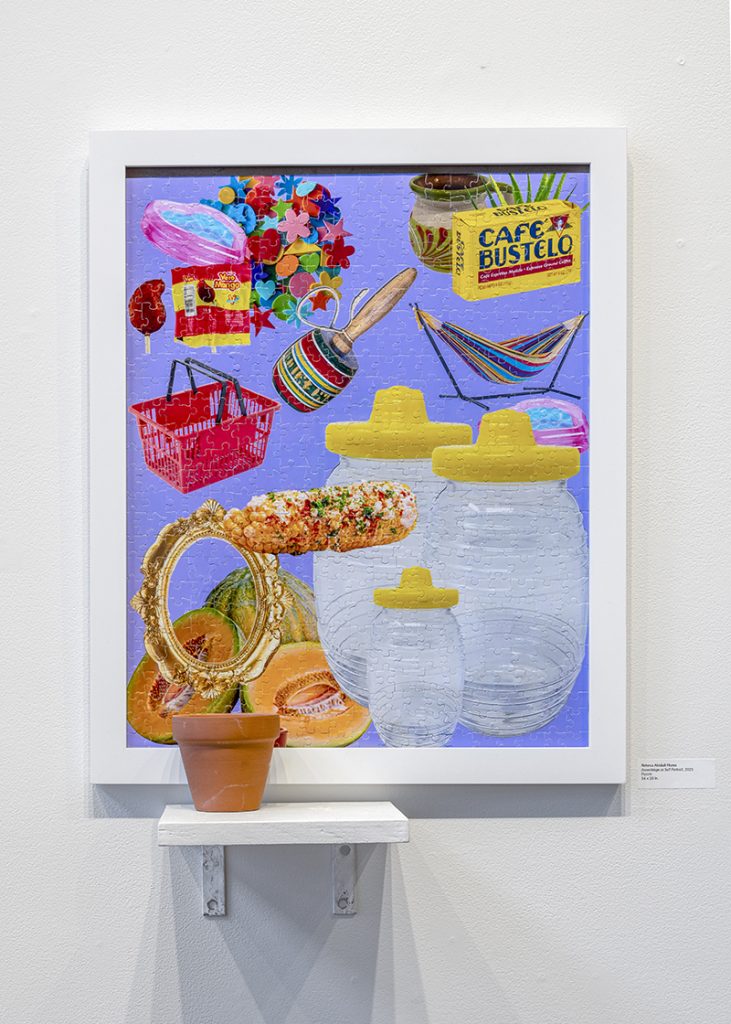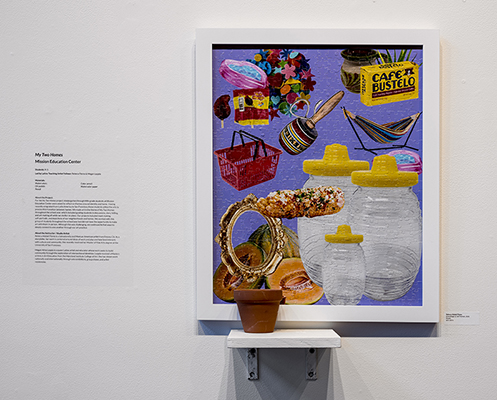
Rebeca Abidail Flores is a Salvadoreña and Mexican American artist from Fresno, CA. As a storyteller, her work is centered around ideas of work and play and how land interacts with culture and community. She recently received her Master of Fine Arts degree at the University of San Francisco.
Flores is currently one of Root Division’s Latinx Teaching Artist Fellows. This fellowship provides free studio workspace to two Latinx artists in exchange for being an integral part of Root Division’s Studios Program. In large part, the commitment involves teaching students at Mission Education Center (MEC), a K-5 newcomer school for children who have recently emigrated from Latin America to San Francisco. Working as a teaching-artist in residence for the full school year, Flores develops and facilitates projects in Root Division’s My Two Homes curriculum, which guides students in discussions, story-telling, and art-making around in their transition to a new home in the U.S.
Flores’ work is currently on view in the main gallery alongside her students as a part of New Growth 2021: Courage in Creativity, the annual Youth Art Exhibition featuring student artwork created in Root Division’s free after-school Youth Education Program.
Read more below to see Education Fellow Rebecca Sexton’s interview with Rebeca Flores about her experience as a Latinx Teaching Artist Fellow, as well as her own artistic practice.

Rebecca Sexton(Education Fellow): Can you describe your work and your practice? What choices do you make, and why are they important to you?
Rebeca Flores (Teaching Fellow): In terms of choices, I ultimately want to tell you a story. An installation, to me, is a story, and so what goes into my prep and my process is figuring out how I can tell you a story. I feel like I’m in competition with phones, and Twitter is far more interesting than me. I feel like storytelling is the easiest thing that we can grasp onto. We don’t really understand a lot, but we can tell ourselves a story. I feel like storytelling is my medium, versus installations or writing. I try to think about how I can get to the best story possible. Sometimes I can write it, and sometimes I can’t write it. I am always trying to figure out what is the best way to convey the story I am trying to tell.
I tend to look a lot at labor and what that means in terms of physical work. I am from the Central Valley, so I grew up around a lot of agriculture. I grew up around a lot of brown people being field workers. My parents are there; my mom is a cleaning lady for a house and my dad is a janitor in a school. I grew up watching a lot of people work, and so a lot of my practice is challenging the childhood I didn’t really get because I had to work with them. But also, at the same time, I am thinking about how we can make play in the world that we live in now. I don’t think I’m going to solve it. In my lifetime, people will still have to work, so I introduce play as a way to counteract that overemphasis on work. I always try to use household items that are already around that you can also play with because I never want to be discouraged by a lack of access.
RS: How are you thinking about labor? What do you mean when you use the word labor, and how does that relate to what you think of its play?
RF: When I talk about labor, I mean physical work that you have to take in, like picking fruit off of like the fields, cleaning houses, or maintaining houses. I guess I should just say physical labor. What I mean is it’s hard work, I think, to leave your home country like my parents did and how many people do to come and work. When I think of play, I think of those possibilities, those dreams, that you think of when you’re done working that don’t always get to be enjoyed. When I mean play, I really mean rest and how are we letting our brains rest. This idea has come from my parents. They used to work in the fields, but then my dad couldn’t take it. He would always say “you know it’s just too hard work I’d rather scrub than to pick,” which is really interesting to me. My dad has a really nice yard, and he has the best trees and the best lawn. So, even though he didn’t want to go into the fields to work, he still kind of did, but it is more playful and on his own time. It is his rest; it’s where he finds joy. I guess what I’m trying to do is frame a different possibility. Even if you do work physical work, how we find our rest is way more important and that’s what I mean by play.
RS: Recently, it seems that much of your work has been based in installation and writing. How do you see these aspects of your practice working together? Is there any tension between them? How are you working with language in the multiple aspect of your practice?

RF: Well, I’m bilingual and English is my second language. I always have to translate everything in my head before I can speak. Recently, that initial translation has been going away, which makes me sad because that means I’m losing my Spanish. If I talk more in Spanish, then I get really confused in English and then that makes me sad because I am losing my English. I think living like this has always been a little bittersweet because language makes up the bulk of our communication. Not being fluent in two things that I feel like I should be fluent in gets really complicated. I don’t always feel the most comfortable in Spanish, and I don’t feel really comfortable in English. But in an installation, I can put things that resonate with who I am as a person outside of language. When I write stories, I have to be okay losing some of my audience based on my use of English or Spanish. I don’t really like that feeling. Sometimes I combat that feeling with making installations because I don’t lose anybody. You know, you see it, and you might not understand it, but I didn’t lose you—you’re still right here. In my installations, I play around with the placement of a bottle or the sunglasses or whatever. I have more room to play. I feel like installation, as a medium, has given me more permission to play. I haven’t made a story that was an installation, and I haven’t made an installation into story. Maybe that will be next!
RS: Can you describe the work that you have done this past year as one of Root Division’s Latinx Teaching Artist Fellow?
RF: I didn’t do it alone. I did it with Megan [Leppla], who is my co-Latinx Fellow. Each week, we make a new lesson with the kids who are in second and third grade. We’re doing all of this on Zoom. A lot of our lessons are allowing students to have their free creative time. We did a lot of self-portraits. We did a lot of things like treehouses in the sky. In our very first lesson, we were exploring lines and color. We basically just let the kiddos sketch for the hour. Other times, we made things that reminded us of home. One time, we showed them Starry Night [by Vincent van Gogh]. They didn’t like it. But they couldn’t stop talking about it! Looking at that piece of art brought up so many questions for them. They kept asking about why the trees and colors were portrayed in certain ways. It was amazing!
Every week, we tried to make a space for the kids where they could play and explore. We’ve had them draw inventions, where some students made tarantula robots or ovens that you could both sleep in and make pizza in. Other students did a lot of chore robots because they don’t like doing chores. We did a lesson where we drew bears. In another lesson that I really liked, we drew a rocket. But before we got to the rocket, I showed them all these different kinds of animals that have been to space like a dog, a bunny, and a monkey. If you want to go to space, you can go to space, we can make that happen. We just try to encourage them, and let them dream their dreams.
One of my favorite lessons was one where we talked about how chameleons change colors when they are sad, when they are in a different temperature, and when their environments change. During this lesson, a student shared a story about when their family was leaving Honduras and crossing the border. They saw a chameleon at the border, but they have never seen one again. It was such a powerful and real moment. All I could do to respond was to encourage that kiddo to draw the chameleon, so that they could see it again.

RS: How has your experience as the Latinx Teaching Artist Fellow affected you? How has it influenced your own artistic practice?
RF: I feel like the kids have taught me more than I have taught them because they taught me how to let go and how to just let something exist in play. They have so many ideas. I was really humbled to work with the kids because most of them are from Honduras, which is the neighboring country to where my dad is from, El Salvador. I am Central American—and I’m also half Mexican, so I felt like I had a chance to be the art teacher I wish I had when I was their age. I didn’t have an art class until I was in high school and by then it was too late. What I wanted out of being the Latinx Fellow was to inspire some confidence and leave some play.
The kids are immigrants,that are learning to speak a certain language, to act a certain way, and that’s not encouraging. We have tried to create an environment where we are telling them yes. I never wanted to tell them no because the world is doing that enough already. That’s been the work I did—trying to create an environment where the kids could be whatever they wanted to be, explore what they wanted to, and also know that all of their choices are beautiful.
RS: Finally, can you talk a little bit about the piece of work you’ve chosen to display alongside your students’ work?
RF: Because of COVID, all of our classes have been virtual, and some of the students have just started returning to school. This is making it a challenge to get work from everybody. I have thought about my own pieces in two ways: I can install one of my paletas, which is the biggest thing I’ve done, or I can install a puzzle I have recently made that is a self-portrait of who I am as a person now. The puzzle is made of a pile of foam stickers. I feel like this piece expresses all sorts of possibilities. It is about trying to put things in place, and thinking about the things we gather around us. It’s about discovering what fits and what doesn’t fit with me as an artist. I think it’s a cool piece, because I feel like that’s sort of the evolution of me, as a person.
